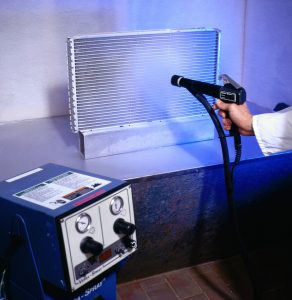Flux Characteristics and Transfer Systems in Electrostatic Application – Part 1

Introduction:
This article summarizes some experimental results of a project on electrostatic application of non-corrosive fluxes for aluminum brazing. The objective is to qualify and quantify flux powder properties and equipment parameters with positive effect for dry flux technology.
For more than 30 years, controlled atmosphere brazing (CAB) [NOCOLOK ® Flux brazing] has been the leading technology for the manufacture of aluminum heat exchangers for the automotive industry.
The most common flux application method is by spraying an aqueous suspension. Constantly agitated flux slurries with concentrations of approximately 10 – 35% solids are pumped from tanks to fluxing booths. All aluminum surfaces involved in the brazing process are coated with the slurry, resulting in a uniform flux layer. Excess flux slurry is removed with a high-volume air blow; the excess is then collected, recycled and reused in the fluxing booth. Before going into the furnace, the heat exchangers are pre-dried in a separate drying oven to remove residual moisture.
In wet flux application, the following are critical factors and need specific observation by the user:
- Flux slurry concentration
- Consistency and uniformity of applied flux
- Flux loading on heat exchangers
- Drying step
Depending on the particular brazing operation, flux slurries may become contaminated with dust, metal particles, rust and organic compounds. The used slurry also contains the soluble portion of the flux (i.e., small levels of potassium, fluoride and aluminum), and must therefore be treated and then disposed of in accordance with environmental regulations.
Over the past five years, some users of NOCOLOK brazing technology have implemented dry flux application methods. Based on the principles of powder paint technology, an alternative application technique was introduced in the brazing industry.
The benefits of electrostatic application are directly related to the problems of wet application:
- No need to mix slurries
- No need to monitor slurry concentration
- No need for a surface wettability concept (i.e., surface treatment or wetting agent)
- No separate drying step required to remove moisture
- No waste water effluent
Particularly when dry fluxing is used in connection with evaporative oils and lubricants, the objective is to eliminate or significantly reduce water consumption during the process.
To be continued …

Hinterlasse einen Kommentar
An der Diskussion beteiligen?Hinterlasse uns deinen Kommentar!